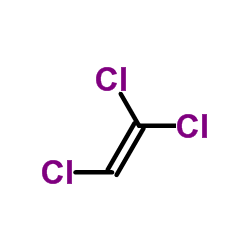Trichloroethylene

Trichloroethylene structure
|
Common Name | Trichloroethylene | ||
|---|---|---|---|---|
| CAS Number | 79-01-6 | Molecular Weight | 131.388 | |
| Density | 1.5±0.1 g/cm3 | Boiling Point | 87.2±0.0 °C at 760 mmHg | |
| Molecular Formula | C2HCl3 | Melting Point | -86 °C | |
| MSDS | Chinese USA | Flash Point | 12.1±17.4 °C | |
| Symbol |

GHS08 |
Signal Word | Danger | |
|
A method for quantification of volatile organic compounds in blood by SPME-GC-MS/MS with broader application: From non-occupational exposure population to exposure studies.
J. Chromatogr. B. Analyt. Technol. Biomed. Life Sci. 992 , 76-85, (2015) Humans are continuously exposed to volatile organic compounds (VOCs) as these chemicals are ubiquitously present in most indoor and outdoor environments. In order to assess recent exposure to VOCs for population-based studies, VOCs are measured in the blood o... |
|
|
Toxicity of zero-valent iron nanoparticles to a trichloroethylene-degrading groundwater microbial community.
J. Environ. Sci. Health. A. Tox. Hazard. Subst. Environ. Eng. 50 , 794-805, (2015) The microbiological impact of zero-valent iron used in the remediation of groundwater was investigated by exposing a trichloroethylene-degrading anaerobic microbial community to two types of iron nanoparticles. Changes in total bacterial and archaeal populati... |
|
|
Cheminformatics analysis of assertions mined from literature that describe drug-induced liver injury in different species.
Chem. Res. Toxicol. 23 , 171-83, (2010) Drug-induced liver injury is one of the main causes of drug attrition. The ability to predict the liver effects of drug candidates from their chemical structures is critical to help guide experimental drug discovery projects toward safer medicines. In this st... |
|
|
Developing structure-activity relationships for the prediction of hepatotoxicity.
Chem. Res. Toxicol. 23 , 1215-22, (2010) Drug-induced liver injury is a major issue of concern and has led to the withdrawal of a significant number of marketed drugs. An understanding of structure-activity relationships (SARs) of chemicals can make a significant contribution to the identification o... |
|
|
A predictive ligand-based Bayesian model for human drug-induced liver injury.
Drug Metab. Dispos. 38 , 2302-8, (2010) Drug-induced liver injury (DILI) is one of the most important reasons for drug development failure at both preapproval and postapproval stages. There has been increased interest in developing predictive in vivo, in vitro, and in silico models to identify comp... |
|
|
QSPR modeling of octanol/water partition coefficient for vitamins by optimal descriptors calculated with SMILES.
Eur. J. Med. Chem. 43 , 714-40, (2008) Simplified molecular input line entry system (SMILES) has been utilized in constructing quantitative structure-property relationships (QSPR) for octanol/water partition coefficient of vitamins and organic compounds of different classes by optimal descriptors.... |
|
|
Control of heterogeneous nucleation and growth kinetics of dopamine-melanin by altering substrate chemistry.
Langmuir 31(11) , 3451-8, (2015) Dopamine-melanin (DM or "polydopamine") can be deposited on virtually any substrate from solution through autoxidation of dopamine. The versatility of this process has allowed surface-mediated assembly of DM for a wide variety of functional coatings. Here we ... |
|
|
Air to lung partition coefficients for volatile organic compounds and blood to lung partition coefficients for volatile organic compounds and drugs.
Eur. J. Med. Chem. 43 , 478-85, (2008) Values of in vitro gas to lung partition coefficients, K(lung), of VOCs have been collected from the literature. For 44 VOCs, application of the Abraham solvation equation to log K(lung) yielded a correlation with R(2)=0.968 and S.D.=0.25 log units. Combinati... |
|
|
Trichloroethylene and trichloroethanol-induced formic aciduria and renal injury in male F-344 rats following 12 weeks exposure.
Toxicology 323 , 70-7, (2014) Trichloroethylene (TCE) is widely used as a cleaning and decreasing agent and has been shown to cause liver tumours in rodents and a small incidence of renal tubule tumours in male rats. The basis for the renal tubule injury is believed to be related to metab... |
|
|
Acidification due to microbial dechlorination near a trichloroethene DNAPL is overcome with pH buffer or formate as electron donor: experimental demonstration in diffusion-cells.
J. Contam. Hydrol. 147 , 25-33, (2013) Acidification due to microbial dechlorination of trichloroethene (TCE) can limit the bio-enhanced dissolution of TCE dense non-aqueous phase liquid (DNAPL). This study related the dissolution enhancement of a TCE DNAPL to the pH buffer capacity of the medium ... |